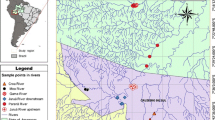Abstract
The present study demonstrates the influence of physical systems (mixed and stratified waters) on the occurrence and distribution of the anisakid nematode Hysterothylacium aduncum in commercially important gadiform fish species from the central and northern North Sea. Stratified waters are essential in structuring marine food webs and are therefore also important for the transfer of fish parasites to their host species. During two research cruises in 2001, 308 haddocks (Melanogrammus aeglefinus) and 203 whitings (Merlangius merlangus) were caught in the central and northern North Sea and were examined for anisakid nematode parasites and food composition. Additionally, the most abundant pelagic invertebrates, hyperiid amphipods, of the investigated area were sampled and examined with regard to their parasite infestation rates. The influence of stratified waters on the infestation of the gadiform fish species by H. aduncum was shown by ecological and parasitological investigations. In stratified areas haddocks and whitings feed specifically and invariably on pelagic hyperiids. The number of ingested hyperiids in these areas was in both fish species correlated with infestation rates of H. aduncum. Therefore, hyperiids were identified as the obligatory intermediated host of H. aduncum, since these crustaceans carried high numbers of nematode larvae in their haemocoel. The results of the present study demonstrate that haddocks and whitings from the stratified waters are highly parasitised, both in terms of the numbers of individuals of larval and adult stages of H. aduncum.


Similar content being viewed by others
References
Auel H, Harjes M, da Rocha E, Stübing D, Hagen W (2002) Lipid biomarkers indicate different ecological niches and trophic relationships of the Arctic hyperiid amphipods Themisto abyssorum and T. libellula. Polar Biol 25:374–383
Balbuena JA, Karlsbakk E, Saksvik M, Kvenseth AM, Nylund A (1998) New data on the early development of Hysterothylacium aduncum (Nematoda, Anisakidae). J Parasitol 84:615–617
Bush AO, Lafferty KH, Lotz JM, Shostak AW (1997) Parasitology meets ecology on its own terms: Margolis et al. revisited. J Parasitol 83:575–583
Dalpadado P, Borkner N, Bogstad B, Mehl S (2001) Distribution of Themisto (Amphipoda) spp. in the Barents Sea and predator-prey interactions. ICES J Mar Sci 58:876–895
Hartwich G (1975) Schlauchwürmer, Nemathelminthes, Rund—oder Fadenwürmer, Nematoda parasitische Rundwürmer von Wirbeltieren. I. Rhabditida und Ascaridida. Die Tierwelt Deutschlands, Fischer, Jena
Hyslop EJ (1980) Stomach content analysis—a review of methods and their application. J Fish Biol 17:411–429
Klimpel S, Seehagen A, Palm HW, Rosenthal H (2001) Deep-water metazoan fish parasites of the world. Logos, Berlin, Germany
Klimpel S, Palm HW, Seehagen A (2003a) Metazoan parasites and food composition of juvenile Etmopterus spinax (L., 1758) (Dalatiidae, Squaliformes) from the Norwegian Deep. Parasitol Res 89:245–251
Klimpel S, Seehagen A, Palm HW (2003b) Metazoan parasites and feeding behaviour of four small-sized fish species from the central North Sea. Parasitol Res 91:290–207
Klimpel S, Palm HW, Rückert S, Piatkowski U (2004) The life cycle of Anisakis simplex in the Norwegian Deep (northern North Sea). Parasitol Res 94:1–9
Køie M (1993) Aspects of the life-cycle and morphology of Hysterothylacium aduncum (Rudolphi, 1802) (Nematoda, Ascaridoidea, Anisakidae). Can J Zool 71:1289–1296
Lick R (1991) Untersuchungen zu Lebenszyklus (Krebse–Fische–marine Säuger) und Gefrierresistenz anisakider Nematoden in Nord-und Ostsee. Ber Inst Meereskd Kiel 218:1–195
Marcogliese DJ (1996) Larval nematodes infection marine crustaceans in eastern Canada. 3. Hysterothylacium aduncum. J Helminthol Soc Wash 63:12–18
Munk P, Nielsen TG (1994) Trophodynamics of the plankton community at Dogger Bank: predatory impact by larval fish. J Plankton Res 16:1225–1245
Navone GT, Sardella NH, Timi JT (1998) Larvae and adults of Hysterothylacium aduncum (Rudolphi, 1802) (Nematoda: Anisakidae) in fishes and crustaceans in the South West Atlantic. Parasite 5:127–136
Øresland V (1986) Parasites of the chaetognath Sagitta setosa in the western English Channel. Mar Biol 92:87–91
Palm HW, Klimpel S, Bucher C (1999) Checklist of metazoan fish parasites of German coastal waters. Ber Inst Meereskd Kiel 307:1–148
Parker GA, Chubb JC, Ball MA, Roberts GN (2003) Evolution of complex life cycles in helminth parasites. Nature 425:480–484
Petter AJ, Cabaret J (1995) Ascaridoid nematodes of teleostean fishes from the eastern North Atlantic and seas of the north of Europe. Parasite 2:217–230
Pinkas L, Oliphant MS, Iverson ILK (1971) Food habits of albacore, bluefin tuna and bonito in California waters. Calif Dep Fish Game, Fish Bull 182:1–105
Richardson K, Nielsen TG, Bo Pedersen F, Heilmann JP, Lokkegaard B, Kaas H (1998) Spatial heterogeneity in the structure of the planktonic food web in the North Sea. Mar Ecol Prog Ser 168:197–211
Riemann F (1988) Nematoda. In: Higgins RP, Thiel H (eds) Introduction to the study of meiofauna. Smithsonian Institution Press, Washington, DC, USA, pp 293–301
Sheader M, Evans F (1975) Feeding and gut structure of Parathemisto gaudichaudi (Guerin) (Amphipoda, Hyperiidae). J Mar Biol Assoc UK 55:641–656
Svendsen YS (1990) Hosts of third stage larvae of Hysterothylacium sp. (Nematoda, Anisakidae) in zooplankton from outer Oslofjord, Norway. Sarsia 75:161–167
Acknowledgements
We are grateful to Svenja Hauschildt, LBS Hamburg (Germany), for kindly revising an earlier draft of the manuscript. Thanks to Dietrich Schnack, IFM-GEOMAR Kiel (Germany), for providing fish material and for providing additional information. The present study was supported by the Commission of the European Community (Q5RS-2000-30183).
Author information
Authors and Affiliations
Corresponding author
Additional information
An erratum to this article can be found at http://dx.doi.org/10.1007/s00436-005-1487-3
Rights and permissions
About this article
Cite this article
Klimpel, S., Rückert, S. Life cycle strategy of Hysterothylacium aduncum to become the most abundant anisakid fish nematode in the North Sea. Parasitol Res 97, 141–149 (2005). https://doi.org/10.1007/s00436-005-1407-6
Received:
Accepted:
Published:
Issue Date:
DOI: https://doi.org/10.1007/s00436-005-1407-6




